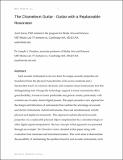The Chameleon Guitar—Guitar with a Replaceable Resonator
Author(s)
Paradiso, Joseph A; Zoran, Amit
Downloadchameleon guitar.pdf (1.170Mb)
OPEN_ACCESS_POLICY
Open Access Policy
Creative Commons Attribution-Noncommercial-Share Alike
Terms of use
Metadata
Show full item recordAbstract
Each acoustic instrument is one of a kind. Its unique acoustic properties are transferred from the physical characteristics of its source materials and a handcrafted touch. In contrast, electronic and computer-based instruments lack this distinguishing trait. Though the technology support in musical instruments offers great flexibility, it tends to foster predictable and generic results, particularly with common use of easily-cloned digital presets. This paper presents a new approach to the design and fabrication of instruments that combine the advantage of acoustic and electric instruments—hybrid instruments—that exist simultaneously in both physical and digital environments. This approach exploits physical/acoustic properties via a replaceable physical object complemented by a simulated shape or other digital signal manipulation. The key concepts of this approach are presented through an example: The Chameleon Guitar, detailed in this paper along with evaluation from musicians and instrument makers. This work aims to demonstrate the possibility of maintaining the qualities found in real acoustic instruments, such as unique spectral and spatial behaviour of wooden soundboards, with the flexibility of digital processing.
Date issued
2011-03Department
Program in Media Arts and Sciences (Massachusetts Institute of Technology)Journal
Journal of New Music Research
Publisher
Informa UK (Taylor & Francis)
Citation
Zoran, Amit, and Joseph A. Paradiso. “The Chameleon Guitar—Guitar with a Replaceable Resonator.” Journal of New Music Research 40.1 (2011): 59–74.
Version: Author's final manuscript
ISSN
0929-8215
1744-5027